
|
FDA GRANDFATHER Clause Petition |

|
|---|
Dated: May 21, 1999
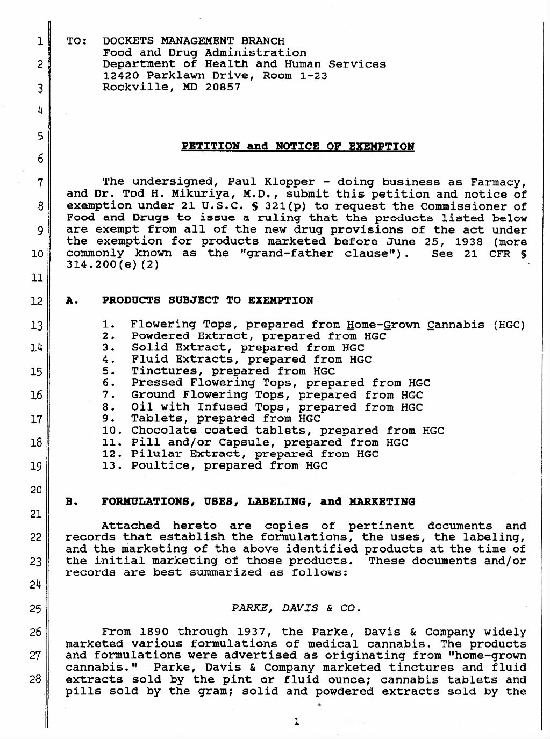
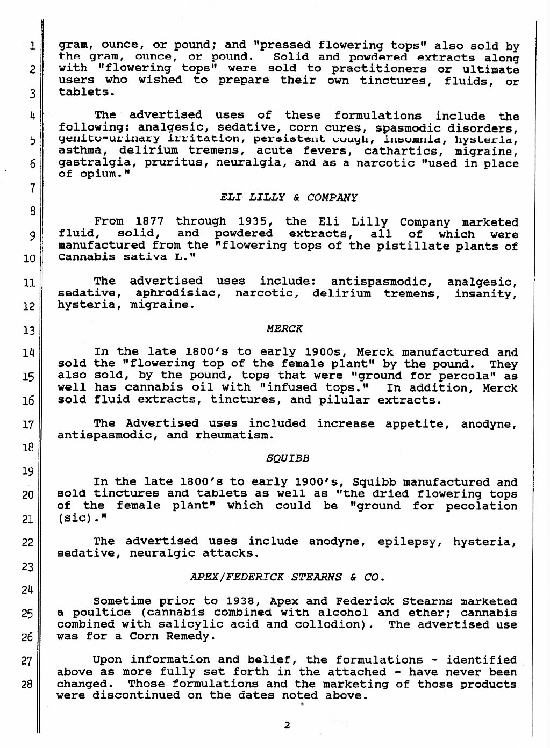
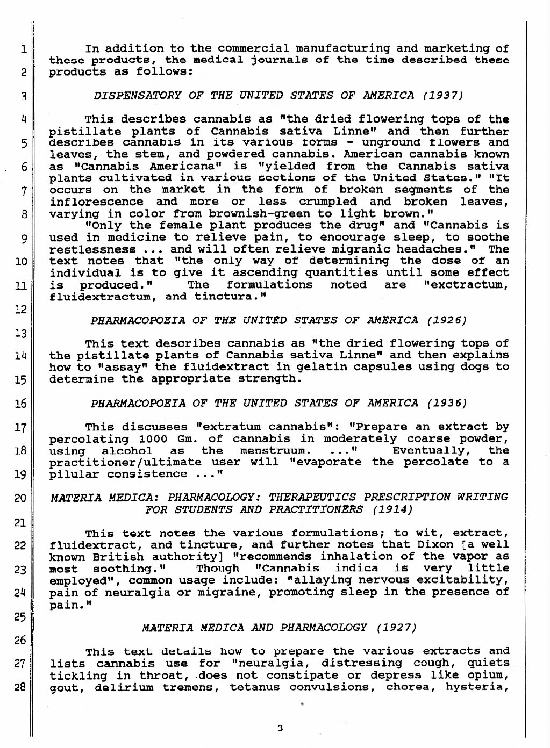
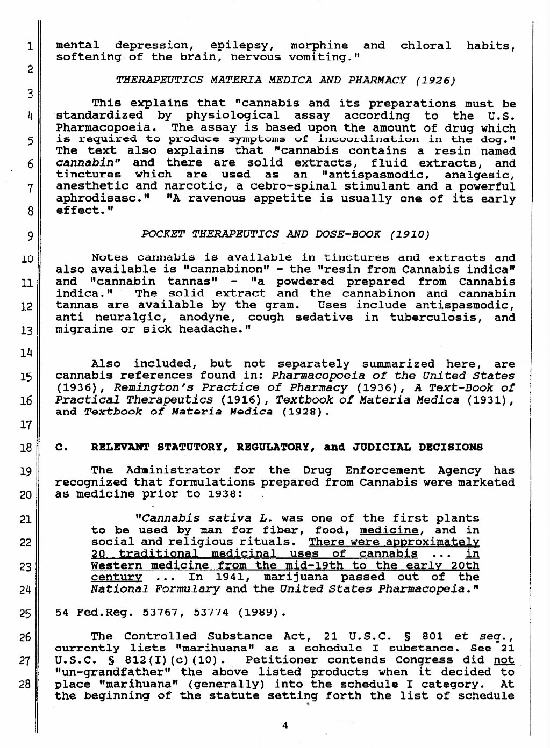
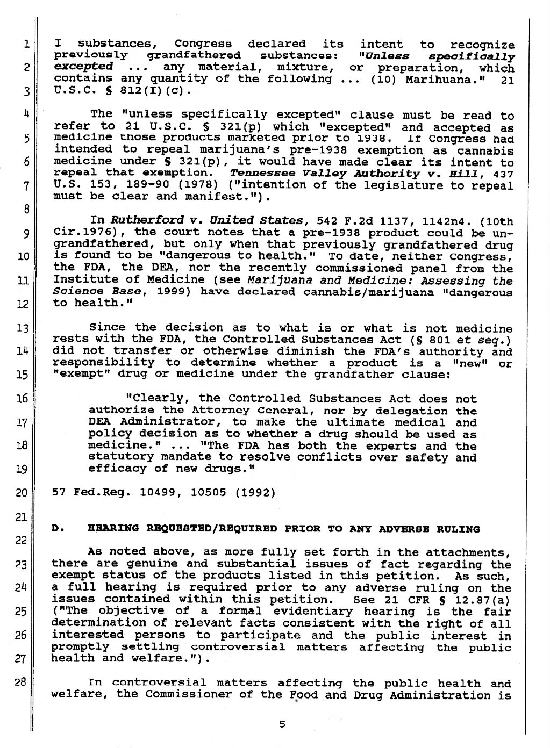

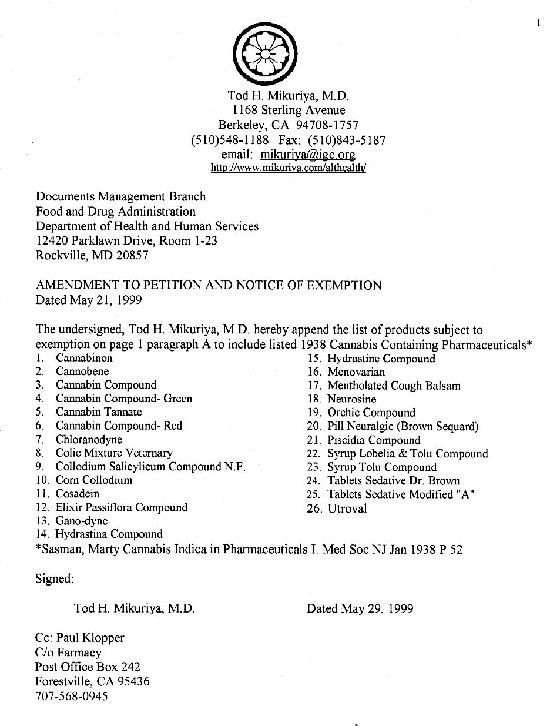
[Warning: -- It is possible that a few transcriber errors have been made. Hopefully they have been kept to a minimum.
TO:DOCKETS MANAGEMENT BRANCH
Food and Drug Administration
Department of Health and Human Services
12420 Parklawn Drive, Room 1-23
Rockville, MD 20857
PETITION and NOTICE OF EXEMPTION
The undersigned, Paul Klopper - doing business as Farmacy, and Dr. Tod Mikuriya, M.D. submit this petition and notice of exemption under 21 U.S.C. § 321(p) to request the Commissioner of Food and Drugs to issue a ruling that the products listed below are exempt from all of the new drug provisions of the act under the exemption for products marketed before June 25, 1938 (more commonly known as the "grand- father clause"). 21 CFR § 314.200(e)(2)
A. PRODUCTS SUBJECT TO EXEMPTION
-
1. Flowering Tops, prepared from Home-Grown Cannabis (HGC)
2. Powdered Extract, prepared from HGC
3. Solid Extract, prepared from HGC
4. Fluid Extracts, prepared from HGC
5. Tinctures, prepared from HGC
6. Pressed Flowering Tops, prepared from HGC
7. Ground Flowering Tops, prepared from HGC
8. Oil with Infused Tops, prepared from HGC
9. Tablets, prepared from HGC
10. Chocolate coated tablets, prepared from HGC
11. Pill and/or Capsule, prepared from HGC
12. Pilular Extract, prepared from HGC
13. Poultice, prepared from HGC
PARKE, DAVIS & CO.
From 1890 through 1937, the Parke, Davis & Company widely marketed various formulations of medical cannabis. The products and formulations were advertised as originating from "home-grown cannabis." Parke, Davis & Company marketed tinctures and fluid extracts sold by the pint or fluid ounce; cannabis tablets and pills sold by the gram; solid and powdered extracts sold by the gram, ounce, or pound; and "pressed flowering tops" also sold by the gram, ounce, or pound. Solid and powdered extracts along with "flowering tops" were sold to practitioners or ultimate users who wished to prepare their own tinctures, fluids, or tablets.
The advertised uses of these formulations include the following: analgesic, sedative, corn cures, spasmodic disorders, genito-urinary irritation, persistent cough, insomnia, hysteria, asthma, delirium tremens, acute fevers, cathartics, migraine, gastralgia, pruritus, neuralgia, and as a narcotic "used in place of opium."
ELI LILLY & COMPANY
From 1877 through 1935, the Eli Lilly Company marketed fluid, solid, and powdered extracts, all of which were manufactured from the "flowering tops of the pistillate plants of Cannabis sativa L." The advertised uses include: antispasmodic, analgesic, sedative, aphrodisiac, narcotic, delirium tremens, insanity, hysteria, migraine.
MERCK
In the late 1800's to early 1900s, Merck manufactured and sold the "flowering top of the female plant" by the pound. They also sold, by the pound, tops that were "ground for percola" as well has cannabis oil with "infused tops." In addition, Merck sold fluid extracts, tinctures, and pilular extracts.
The Advertised uses included increase appetite, anodyne, antispasmodic, and rheumatism.
SQUIBB
In the late 1800's to early 1900's, Squibb manufactured and sold tinctures and tablets as well as "the dried flowering tops of the female plant" which could be "ground for pecolation (sic)."
The advertised uses include anodyne, epilepsy, hysteria, sedative, neuralgic attacks.
APEX/FEDERICK STEARNS & CO.
Sometime prior to 1938, Apex and Federick Stearns marketed a poultice (cannabis combined with alcohol and ether; cannabis combined with salicylic acid and collodion). The advertised use was for a Corn Remedy.
Upon information and belief, the formulations - identified above as more fully set forth in the attached - have never been changed. Those formulations and the marketing of those products were discontinued on the dates noted above. In addition to the commercial manufacturing and marketing of these products, the medical journals of the time described these products as follows:
DISPENSATORY OF THE UNITED STATES OF AMERICA (1937)
This describes cannabis as "the dried flowering tops of the pistillate plants of Cannabis sativa Linne" and then further describes cannabis in its various forms - unground flowers and leaves, the stem, and powdered cannabis. American cannabis known as "Cannabis Americana" is "yielded from the Cannabis sativa plants cultivated in various sections of the United States." "It occurs on the market in the form of broken segments of the inflorescence and more or less crumpled and broken leaves, varying in color from brownish-green to light brown." "Only the female plant produces the drug" and "Cannabis is used in medicine to relieve pain, to encourage sleep, to soothe restlessness ... and will often relieve migranic headaches." The text notes that "the only way of determining the dose of an individual is to give it ascending quantities until some effect is produced." The formulations noted are "exctractum, fluidextractum, and tinctura."
PHARMACOPOEIA OF THE UNITED STATES OF AMERICA (1926)
This text describes cannabis as "the dried flowering tops of the pistillate plants of Cannabis sativa Linne" and then explains how to "assay" the fluidextract in gelatin capsules using dogs to determine the appropriate strength.
PHARMACOPOEIA OF THE UNITED STATES OF AMERICA (1936)
This discusses "extratum cannabis": "Prepare an extract by percolating 1000 Gm. of cannabis in moderately coarse powder, using alcohol as the menstruum. ..." Eventually, the practitioner/ultimate user will "evaporate the percolate to a pilular consistence ..."
MATERIA MEDICA: PHARMACOLOGY: THERAPEUTICS PRESCRIPTION WRITING FOR STUDENTS AND PRACTITIONERS (1914)
This text notes the various formulations; to wit, extract, fluidextract, and tincture, and further notes that Dixon [a well known British authority] "recommends inhalation of the vapor as most soothing." Though "Cannabis indica is very little employed", common usage include: "allaying nervous excitability, pain of neuralgia or migraine, promoting sleep in the presence of pain."
MATERIA MEDICA AND PHARMACOLOGY (1927)
This text details how to prepare the various extracts and lists cannabis use for "neuralgia, distressing cough, quiets tickling in throat, does not constipate or depress like opium, gout, delirium tremens, tetanus convulsions, chorea, hysteria, mental depression, epilepsy, morphine and chloral habits, softening of the brain, nervous vomiting."
THERAPEUTICS MATERIA MEDICA AND PHARMACY (1926)
This explains that "cannabis and its preparations must be standardized by physiological assay according to the U.S. Pharmacopoeia. The assay is based upon the amount of drug which is required to produce symptoms of incoordination in the dog." The text also explains that "cannabis contains a resin named cannabin" and there are solid extracts, fluid extracts, and tinctures which are used as an "antispasmodic, analgesic, anesthetic and narcotic, a cebro-spinal stimulant and a powerful aphrodisasc." "A ravenous appetite is usually one of its early effect."
POCKET THERAPEUTICS AND DOSE-BOOK (1910)
Notes cannabis is available in tinctures and extracts and also available is "cannabinon" - the "resin from Cannabis indica" and "cannabin tannas" - "a powdered prepared from Cannabis indica." The solid extract and the cannabinon and cannabin tannas are available by the gram. Uses include antispasmodic, anti neuralgic, anodyne, cough sedative in tuberculosis, and migraine or sick headache."
Also included, but not separately summarized here, are cannabis references found in: Pharmacopoeia of the United States (1936), Remington's Practice of Pharmacy (1936), A Text-Book of Practical Therapeutics (1916), Textbook of Materia Medica (1931), and Textbook of Materia Medica (1928).
C. RELEVANT STATUTORY, REGULATORY, and JUDICIAL DECISIONS
The Administrator for the Drug Enforcement Agency has recognized that formulations prepared from Cannabis were marketed as medicine prior to 1938:
"Cannabis sativa L. was one of the first plants to be used by man for fiber, food, medicine, and in social and religious rituals. There were approximately 20 traditional medicinal uses of cannabis ... in Western medicine from the mid-19th to the early 20th century ... In 1941, marijuana passed out of the National Formulary and the United States Pharmacopeia."
54 Fed.Reg. 53767, 53774 (1989).
The Controlled Substance Act, 21 U.S.C. § 801 et seq., currently lists "marihuana" as a schedule I substance. See 21 U.S.C. § 812(I)(c)(10). Petitioner contends Congress did not "un-grandfather" the above listed products when it decided to place "marihuana" (generally) into the schedule I category. At the beginning of the statute setting forth the list of schedule I substances, Congress declared its intent to recognize previously grandfathered substances: "Unless specifically excepted ... any material, mixture, or preparation, which contains any quantity of the following ... (10) Marihuana." 21 U.S.C. § 812(I)(c).
The "unless specifically excepted" clause must be read to refer to 21 U.S.C. § 321(p) which "excepted" and accepted as medicine those products marketed prior to 1938. If Congress had intended to repeal marijuana's pre-1938 exemption as cannabis medicine under § 321(p), it would have made clear its intent to repeal that exemption. Tennessee Valley Authority v. Hill, 437 U.S. 153, 189-90 (1978) ("intention of the legislature to repeal must be clear and manifest.").
In Rutherford v. United States, 542 F.2d 1137, 1142n4. (10th Cir.1976), the court notes that a pre-1938 product could be un- grandfathered, but only when that previously grandfathered drug is found to be "dangerous to health." To date, neither Congress, the FDA, the DEA, nor the recently commissioned panel from the Institute of Medicine (see Marijuana and Medicine: Assessing the Science Base, 1999) have declared cannabis/marijuana "dangerous to health."
Since the decision as to what is or what is not medicine rests with the FDA, the Controlled Substances Act (§ 801 et seq.) did not transfer or otherwise diminish the FDA's authority and responsibility to determine whether a product is a "new" or "exempt" drug or medicine under the grandfather clause:
"Clearly, the Controlled Substances Act does not authorize the Attorney General, nor by delegation the DEA Administrator, to make the ultimate medical and policy decision as to whether a drug should be used as medicine." ... "The FDA has both the experts and the statutory mandate to resolve conflicts over safety and efficacy of new drugs."
57 Fed.Reg. 10499, 10505 (1992)
D. HEARING REQUESTED/REQUIRED PRIOR TO ANY ADVERSE RULING
As noted above, as more fully set forth in the attachments, there are genuine and substantial issues of fact regarding the exempt status of the products listed in this petition. As such, a full hearing is required prior to any adverse ruling on the issues contained within this petition. See 21 CFR § 12.87(a) ("The objective of a formal evidentiary hearing is the fair determination of relevant facts consistent with the right of all interested persons to participate and the public interest in promptly settling controversial matters affecting the public health and welfare.").
In controversial matters affecting the public health and welfare, the Commissioner of the Food and Drug Administration is required to produce a "full administrative record" which includes a "full hearing" to give "proponents an opportunity to express their views." Rutherford, 542 F.2d. at 1143; accord Breitmeyer v. Califano, 463 F.Supp. 810, 815 (E.D.Mich 1978) ("Under 21 CFR § 314.200(d), any interested person may request a hearing. The hearing, once granted, would extend to all issues relating to [the product's] status as a new drug, including exemption under the grandfather clause. 21 CFR § 314.200(e)(2).").
E. CERTIFICATION and VERIFICATION
The undersigned certify, that, to the best knowledge and belief of the undersigned, this petition and notice of exemption includes all information and views on which the petition relies, and that it includes representative data and information known to the petitioners which are both favorable and unfavorable to the petition.
The undersigned verify that all appropriate records have been searched and to the best of their knowledge and belief it includes a true and accurate presentation of the facts.
Signed:
Dated: May 21, 1999
Paul Klopper
c/o Farmacy
Post Office Box 242
Forestville, CA 95436
707/568-0945
Tod H. Mikuriya M.D.
http://www.farmacy.org/petexe.html
WANT TO KNOW MORE:
=====================
Due to space / download time considerations, only selected materials are displayed. If you would like to obtain more information, feel free to contact the museum. All our material is available (at cost) on CD-Rom format.
CONTACT PAGE
FDA PETITION Back to the Previous Addendum |
 BACK TO PETITION INDEX |
FDA PETITION  On to the Next Addendum |